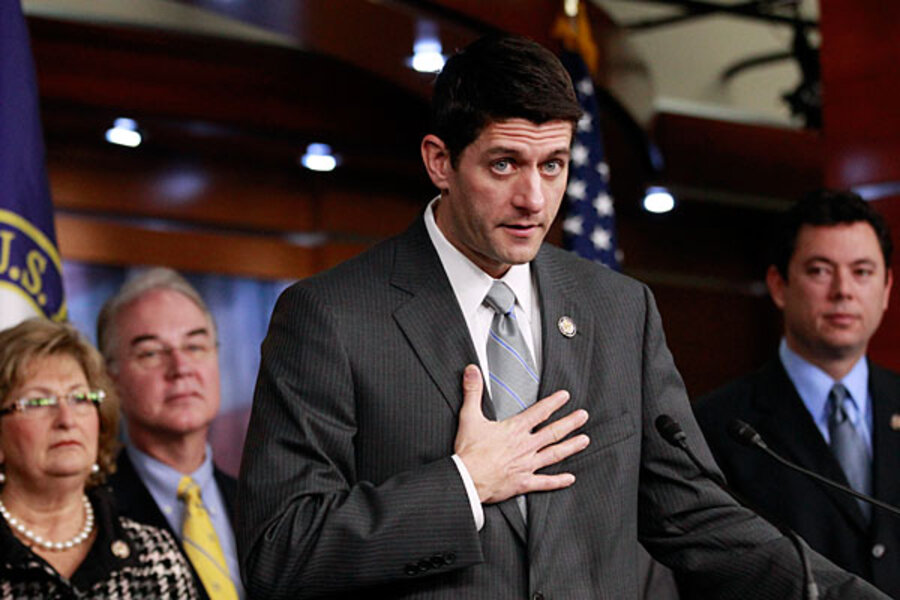Price of debt-ceiling deal: GOP plan goes 'for the jugular,' Dems say
Loading...
| Washington
Facing the prospect of a draconian “sequester” – the across-the-board cuts that were the price of last summer’s debt deal – the Republican-controlled House Budget Committee on Monday approved a plan Democrats say would “go for the jugular” of vulnerable children and seniors.
The proposal would spread the pain of next year’s sequester over a decade to avoid $55 billion in mandated defense cuts. The full House is expected to vote on it Thursday.
The committee passed a pair of bills Monday – the first along party lines 21 to 9, the second on a 21-to-13 vote, with Rep. Justin Amash (R) of Michigan voting with the Democrats in opposition. Together, those bills would lower federal spending by $261 billion over the next decade to head off most of the $109 billion in cuts scheduled to hit in January. They do so through a blend of spending cuts in food and nutrition programs for poor and elderly Americans in the short term, while taking chunks out of President Obama’s signature health-care reform law and raising federal workers’ pension contributions in the long term.
And they left Democrats steaming, with Rep. Lloyd Doggett (D) of Texas holding up a sign dubbing the proceedings “Wreckonciliation.”
“If a political party wanted to undermine the health and economic security of millions of American families, well, this is the way to do it,” said Rep. Kathy Castor (D) of Florida.
The Thursday vote, however, will likely be the end of the proposal in Congress. Even if it passes in the House, it has no chance of clearing the Senate, and Mr. Obama would surely veto it.
But in an election year, the bill is a marker of what Republicans envision for Washington. Moreover, it’s a glimpse of what could happen after the elections, when congressional attempts to avoid next year’s sequester are expected to shift into high gear.
Republicans, for their part, argued that the size of America’s debt makes funding such programs unsupportable.
“We try to solve everyone’s problems all the time,” said Rep. Todd Rokita (R) of Indiana. Unless they are reined in, he added, “these programs won’t be around for the neediest among us.”
Furthermore, Republicans said Democrats aren’t looking at programs like the Supplemental Nutrition Assistant Program (SNAP) – formerly known as food stamps – in a clear-eyed way.
“We spend too much of our time and our intellectual effort measuring compassion for those in need by measuring inputs: How much money are we spending? How many programs are we creating?” House Budget Committee Chairman Paul Ryan (R) of Wisconsin said. “But we’re not measuring outcomes. Are these programs working? Are people getting out of poverty? And we need to focus on that.”
Though the sequester will continue to affect budgets for 10 years, according to the terms of the debt deal, the Republican plan focuses only on the 2013 sequester. To get to the full $109 billion figure, Mr. Ryan's plan would cut $19 billion from the overall budget and keeps in place $12 billion in automatic cuts to mandatory spending including Medicare. He piled up $18 billion in cuts that would take effect in 2013 but leaves the balance to be paid over the coming decade.
But in 2013, cuts to SNAP and other food programs of $7.7 billion would make up just under half of the reductions.
The GOP proposals would stop automatic eligibility for SNAP funds if children are already enrolled in other state or federal support programs. Similarly, the expiration of increases in SNAP benefits implemented as part of the president’s stimulus plan would be moved up from October 2013 to July. These and other changes would put as many as 300,000 children out of free school meals and 2 million Americans out of all SNAP programs altogether.
The question for Democrats, then, was whether the sequester would actually be preferable to the Republicans’ plan. The answer, it seemed, was yes – at least in part.
The budget committee’s top Democrat, Rep. Chris Van Hollen of Maryland, noted that food stamps and children’s health care are off-limits to sequester cuts.
Under one GOP proposal – rolling back minimum standards at the state level for the Children’s Health Insurance Program – as many as 300,000 children would lose their health-care coverage by 2015, said Congressman Van Hollen, citing Congressional Budget Office estimates.







